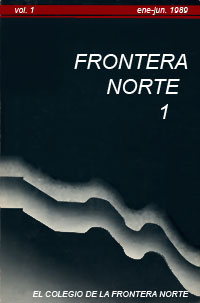Migrants and settlers: a comparison of undocumented Mexican and central americans in the United States
Contenido principal del artículo
Resumen
Detalles del artículo
Las/los autoras/es que publiquen en esta revista aceptan las siguientes condiciones:
- Las/los autoras/es conservan los derechos de autor y ceden a la revista Frontera Norte (RFN) el derecho de la primera publicación, mediante el registro de los textos con la licencia de Creative Commons Atribución-No comercial-Sin derivar 4.0 internacional (CC BY-NC-ND 4.0), que permite a terceros utilizar lo publicado siempre que mencionen la autoría del trabajo y a la primera publicación en esta revista.
- Autorizan que su artículo y todos los materiales incluidos en él sean reproducidos, publicados, traducidos, comunicados y transmitidos públicamente en cualquier forma o medio; así como efectuar su distribución al público en el número de ejemplares que se requieran y su comunicación pública, en cada una de sus modalidades, incluida su puesta a disposición del público a través de medios electrónicos o de cualquier otra tecnología, para fines exclusivamente científicos, culturales, de difusión y sin fines comerciales.
- Los autores/as pueden realizar otros acuerdos contractuales independientes y adicionales para la distribución no exclusiva de la versión del artículo publicado en esta revista (por ejemplo: incluirlo en un repositorio institucional, página web personal; o bien publicarlo en un libro) siempre que sea sin fines comerciales e indiquen claramente que el trabajo se publicó por primera vez en Frontera Norte (RFN), [agregando la ficha bibliográfica correspondiente: Autor/es. (año). Título del artículo. Frontera Norte, volumen (número), pp. doi: xxxx ].
Para ello, los autores deben remitir el formato de carta-cesión de la propiedad de los derechos de la primera publicación debidamente llenado y firmado. Este documento debe cargarse en formato PDF en archivos complementarios dentro de la plataforma OJS.

Este obra está bajo una licencia de Creative Commons Atribución-No comercial-Sin derivar 4.0 internacional (CC BY-NC-ND 4.0).
Citas
Álvarez, R. 1986. La Familia. Berkeley: University of California Press.
Bustamante, J.A. 1983. "The Mexicans are Coming." International Migration Review17: 323-341.
Chaney, E.M. 1982. "Women Who Go and Women Who Stay Behind," Migration Today10 (3/4): 6-14.
Chávez, L.R. 1988. "Settlers and Sojourners: The Case of Mexicans in the United States." Human Organization47(2): 95-108.
--- 1986. "Househlds, Migration, and Labor Market Participation: The Adaptation of Mexicans to Life in the United States." Urban Anthropology14(3).
Chávez, L.R., and E.T. Flores1987. "Undocumented Mexicans and Central Americans and the Immigration Control and Reform Act of 1986: A Reflection Based on Empirical Data", In Defense of the Alien, vol. 10.
Chinchilla N., M. Jamail and N.P. Rodríguez, n.d "Central American Migration to U.S." Mimeograph.
Cornelius, W. A. 1981. "Interviewing Undocumented Immigrants: Methodological Reflections Based on fieldwork in Mexico and the United States." International Migration Review16: 378-411.
Cornelius, W. A., L. R. Chávez and J. Castro1981. "Mexican Immigrants in Southern California: A Summary of Current Knowledge". Research Report No. 36. La Jolla: Center for U.S.-Mexican Studies, University of California, San Diego.
Flores, E. T. 1984. "Research on Undocumented Immigrants and Public Policy: A Study of the Texas School Case." International Migration Review18: 505-523
Kossoudji, S. A. and S. Ranney1984. "Female Migrants: Temporary Mexican Migration to the U. S." International Migration Review18: 1120-1143.
Kritz, M. M., ed. 1983. U.S. Immigration and Refugee Policy. Lexington, Mass.: Lexington Books.
Massey, D., R. Alarcón, J. Durand and H. González1987. Return to Aztlan. Berkeley: University of California Press.
McCarthy, K.F. and R.B. Valdez1986. Current and Future Effects of Mexican Immigration in California. Santa Monica: The Rand Corporation.
Muller, T. and T. Espenshade1985. The Fourth Wave. Washington, D.C.: The Urban Institute Press.
Nalven, J. 1986. "Impacts and Undocumented Persons: The Quest for Useable Data in San Diego County, 1974-1986." San Diego: Institute for Regional Studies of the Californias, San Diego State University.
Passel, J. S. 1985. "Estimates of Undocumented Aliens in the 1980 Census for SMSAs." Memorandum to Roger Herriot, Chief, Population Division, Bureau of the Census, 16 August 1985.
Passel, J. S. and K. A. Woodrow1984. "Geographic Distribution of Undocumented Aliens Counted in the 1980 Census by State." International Migration Review18:642-671.
Pedraza-Bailey, S. 1985. Political and Economic Migrants in America. Austin: University of Texas Press.
Piore, M.J. 1979. Birds of Passage: Migrant Labor and Industrial Societies. London: Cambridge University Press.
Portes, A. and S. Sassen-Koob1987. "Making It Underground: Comparative Material on the Informal Sector In Western Market Economies." American Journal of Sociology93( 1 ):30-61.
Rodríguez, N.P. 1987. "Undocumented Central Americans in Houston: Diverse Populations," International Migration Review21: 4-26.
Ruggles, P. and M. Fix1985. Impacts and Potential Impacts of Central American Migrants on HHS and Related Programs of Assistance. Washington, D. C: The Urban Institute.
Rumbaut, R. and L. R. Chávez, et al. 1988. "The Politics of Migrant Health Care: A Comparative Study of Mexican Immigrants and Indochinese Refugees in San Diego." Research in the Sociology of Medicine7 (forthcoming).
Samora, 1971. Los Mojados. Notre Dame, Ind: Notre Dame Press.
Sassen-Koob, S. 1984. "Notes on the Incorporation of Third World Women into Wage-Labor Through Immigration and Off-Shore Production." International Migration Review(4): 1144-1167.
Simon, R. J. and C. Brettel1986. International Migration: The Female Experience. Totowa, N. J.: Rowman and Allanheld.
U.S. Bureau of the Census1984. Money, Income, and Poverty Status of Families in the United States: 1983. Series P-60, No. 145, Washington, D. C: Government Printing Office, August.
U.S. Bureau of the Census1987. Statistical Abstract of the United States, 107th edition. Washington, D.C.: Government Printing Office.
